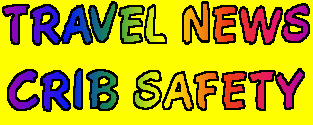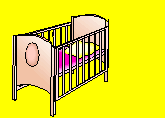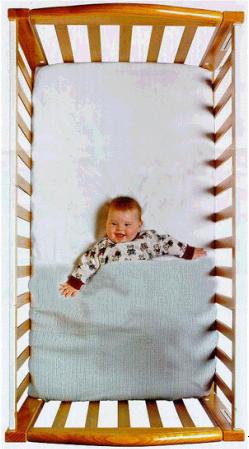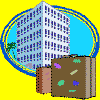|
 
Click on the links to view news about crib
safety or scroll the page
Reminder
about Hotel Crib Safety
Hazards of Soft Bedding
for Babies
Soft
Bedding a Factor in Playpen Deaths
Health Canada Advisory
on the safety of Playpens
Infants Can Suffocate In Mesh Drop-Sided Playpens
www.hotelfun4kids.com
WANTS TO REMIND PARENTS ABOUT HOTEL CRIB
SAFETY - A YEAR-ROUND CONCERN AS MORE FAMILIES TRAVEL AND HOTELS
PROMOTE FAMILY TRAVEL
Folding Crib Recall Notice - CPSC, Hufco-Delaware Company and Evenflo Company Inc. Announce Recall to Repair Gerry® and Evenflo® Portable Wood Cribs - Crib Safety Information for Hotels
The following press release issued by the Consumer Product
Safety Commission
February, 2000, WASHNGTON – The Consumer Product Safety Commission
Tuesday warned that most cribs found in hotels during a recent study were unsafe
for infants and urged all hotels to join a campaign for safer cribs. The warning
stems from safety concerns about a number of cribs and so-called "play
yards" in general and from spot checks at some 90 hotels performed by
volunteers from the Safe Kids Coalition. About 40 deaths occur every year
involving cribs, though not necessarily in hotels.
"Of the 122 cribs that Safe Kids Coalition volunteers
observed," said Heather Paul, executive director of the group, "hazards
were unfortunately observed in half of them. More
than half of cribs were provided with adult sheets
-- a potential cause of strangulation and
suffocation."
The CPSC said unsafe cribs and play yards were found in 80
percent of hotels and motels visited for the study.
"Children under (age) 2 spend seven million
nights a year in hotels," said Commission
Chairman Ann Brown.
Cribs considered to be unsafe can have slats spaced far enough
apart so that an infant's head can get stuck in between them,
they can have bedding that is so soft as to create
a suffocation hazard, and some are designed to
collapse in the middle which could lead to a
child's head getting caught between the two halves of the device. Older cribs
sometimes have exposed corners and slide rails
which can lead to serious injuries if a child's hands or fingers get
caught in them.
Note: This press release was originally
published in February 2000 - For more information on safe bedding,
see below
February, 2000 - The U.S. Consumer Product
Safety Commission (CPSC) and the National SAFE KIDS Campaign today
announced a crib and play yard safety initiative to keep children
safe when traveling with their families. Recent spot checks by
SAFE KIDS found unsafe cribs and play yards in 80 percent of
hotels and motels visited.
Bass Hotels & Resorts, which includes the Inter-Continental,
Holiday Inn, Holiday Inn Express, Staybridge Suites and Crowne
Plaza brands is joining the new safety initiative. CPSC invited 24
national hotel chains to participate in the safety initiative, but
only Bass Hotels & Resorts agreed. CPSC and SAFE KIDS are
encouraging other hotels and motels to participate and have
prepared safety information that they can use to ensure their
cribs are not hazardous.
Bass Hotels & Resorts will provide additional training for
staff and hold a "Crib Safety Week" where each hotel's
housekeeping and maintenance staff will conduct a thorough
inspection of all cribs and play yards. The ongoing inspections
will help ensure that the cribs and play yards meet current safety
standards, are in good repair and have not been recalled. Bass
Hotels & Resorts also plans to include crib safety information
in hotel publications and on its website, and promote crib safety
in media events targeted to begin around Mother's Day. The company
has 2,800 hotels worldwide, including more than 1,300 in the
United States.
Many traveling families use cribs and play yards provided by
motels and hotels. Estimates show that children under age 2 spend
more than 7 million nights per year in hotels, motels and resorts.
CPSC estimates that there are about 65,000 hotels and motels in
the U.S.
SAFE KIDS recently visited 90 hotels and motels in 27 states and
the District of Columbia. Of the cribs inspected, 82 percent had
at least one safety hazard, including loose hardware or lack of
secured mattress supports that could entrap a baby; soft bedding,
including quilts, comforters or pillows that could cause
suffocation; and adult- sized sheets that pose a strangulation and
suffocation hazard. Of the play yards and mesh cribs inspected, 52
percent had at least one safety hazard, including tears or holes
in the meshing, which pose an entrapment risk to babies, and soft
bedding.
The SAFE KIDS spot check gives a snapshot of what consumers might
find while traveling.
Each year, about 40 babies suffocate or strangle in their cribs
when they become trapped between broken crib parts or in cribs
with older, unsafe designs. Soft bedding such as quilts,
comforters or pillows can suffocate a baby. As many as 3,000
infants die each year from Sudden Infant Death Syndrome (SIDS) and
up to one-third of these may have suffocated on soft bedding. CPSC
recommends that a baby under 12 months be put to sleep in a crib
on his or her back with no soft bedding. Adult sheets should never
be used in a crib because they pose a strangulation and
suffocation risk to babies. Hotels and motels should provide
fitted crib sheets in good condition that fit the mattress
securely.
"Whether the hotel is on 5th Avenue or Main Street, there's
no guarantee the crib you request will be safe and in good
repair," said CPSC Chairman Ann Brown. "Parents who are
traveling should not have to worry about the place they put their
child down to sleep. I'm pleased that Bass Hotels and Resorts is
joining this safety campaign. I'm very disappointed that other
hotels are not participating."
Heather Paul, Executive Director of the National SAFE KIDS
Campaign, said: "This informal assessment simply raises a red
flag for the hotel industry that they might unknowingly be putting
babies at risk. We want hotels to know there are simple steps they
can take to help ensure a safe sleeping environment for their
youngest guests."
CPSC encourages parents to ask ahead if the hotel or motel in
which they are planning to stay has a system in place to ensure
their cribs are safe.
Consumer Product Safety
Commission
Soft Bedding May Be Hazardous To Babies
To prevent infant deaths due to soft bedding, the U.S. Consumer Product
Safety Commission, the American Academy of Pediatrics, and the National
Institute of Child Health and Human Development are revising their
recommendations on safe bedding practices when putting infants down to sleep.
Here are the revised recommendations to follow for infants under 12 months:
|
Safe Bedding Practices
For Infants

If using a blanket, put baby with feet at the foot of
the crib. Tuck a thin blanket around the crib mattress,
reaching only as far as the baby's chest.
|
Place baby on his/her back on a firm tight-fitting
mattress in a crib that meets current safety standards.
Remove pillows, quilts, comforters, sheepskins, stuffed
toys, and other soft products from the crib.
Consider using a sleeper or other sleep clothing as an
alternative to blankets, with no other covering.
Make sure your baby's head remains uncovered during
sleep.
Do not place baby on a waterbed, sofa, soft mattress,
pillow, or other soft surface to sleep.
|
Placing babies to sleep on their backs instead of their stomachs has been
associated with a dramatic decrease in deaths from Sudden Infant Death
Syndrome (SIDS). Babies have been found dead on their stomachs with their
faces, noses, and mouths covered by soft bedding, such as pillows, quilts,
comforters and sheepskins. However, some babies have been found dead with
their heads covered by soft bedding even while sleeping on their backs.
U.S. Consumer Product Safety Commission
Web site: www.cpsc.gov
1-800- 638-2772
American Academy of Pediatrics
Web site: www.aap.org
National Institute of Child Health and
Human Development
"Back to Sleep" Campaign
1-800-505- CRIB
Report Finds Soft
Bedding a Factor in Playpen Deaths
CPSC, Mattel Launch Campaign to Alert Caregivers
July 12, 2001, WASHINGTON, D.C -
The U.S. Consumer Product Safety Commission (CPSC) released a
report (pdf) today on deaths in playpens. Since 1988, CPSC has
reports of more than 200 babies who died while in playpens. In
almost 100 of these deaths, soft bedding or improper or extra
mattresses were present in the playpen and the babies died of
suffocation or Sudden Infant Death Syndrome (SIDS). More than 70
percent of these deaths were to babies less than 12 months old.
Twenty-six of the playpen deaths occurred in a daycare setting.
Over the years, playpens, portable cribs and play yards have
evolved into virtually identical products. Parents use playpens
today as places for babies to both sleep and play. To educate
caregivers, CPSC and Mattel, Inc. are launching a "Sleep
Safe, Play Safe " campaign to address the two greatest
hazards revealed by the study: 1) adding soft bedding and 2)
adding extra mattresses or cushions.
For years, CPSC has warned about the dangers of soft bedding such
as quilts, comforters and pillows in cribs. Soft bedding can
become molded around an infant's face and cause suffocation. As
many as one-third of baby deaths attributed to SIDS, in fact, may
be suffocation in soft bedding.
"Many parents and caregivers know the dangers of soft bedding
in cribs," said CPSC Chairman Ann Brown. "This study
shows, for the first time, that the same dangers exist when using
pillows, quilts, and comforters in playpens."
The findings emphasize the need for caregivers to be aware that
the same safe sleeping guidelines that they follow for their
babies' cribs should be followed in these playpens. That means
placing baby on his back on a firm, flat mattress and not adding
extra mattresses or any soft bedding, such as pillows, quilts, or
comforters.
"At Mattel, the well being of children is an inherent part of
the reason for our organization to exist and we reflect this in
all that we do," said Jim Walter, vice president of corporate
product integrity for Mattel. "We are happy to be working
with the CPSC on the 'Sleep Safe, Play Safe' campaign."
Today, CPSC, in partnership with Mattel, is kicking off a
"Sleep Safe, Play Safe" campaign to educate parents and
caregivers about the dangers associated with soft bedding and
extra mattresses or cushions in playpens.
The campaign includes a Public Service Announcement (PSA),
featuring a lullaby by singer/songwriter Tom Paxton, that will be
distributed to 3,400 radio stations nationwide. CPSC will reach
out to practicing pediatricians and organizations that are
influential in educating parents about ways to keep their infants
healthy and safe. Mattel will send more than a million posters and
brochures to practicing pediatricians across the country and to
organizations who work with or serve parents and childcare
providers.
Other hazards identified in the study were playpens that were in
poor condition, had broken or protruding hardware or had side
rails that collapsed creating an entrapment hazard.
To prevent deaths or injuries to children in playpens, parents and
caregivers should take these precautions:
- Before using a playpen, make
sure it has not been recalled. Contact CPSC at 1-800-638-2772
or check the recalls section of CPSC's web site.
- Always put a baby down to
sleep on his back in a playpen or crib with no soft bedding,
such as quilts, comforters and pillows. This can help reduce
the risk of SIDS and prevent suffocation.
- Use only the mattress
provided by the manufacturer. Do not add additional mattresses
in playpens. Children can suffocate in the spaces formed
between mattresses or from ill-fitting mattresses.
- Check that the playpen is in
good shape. Using a modified or improperly repaired unit can
create hazards.
- Make sure the top rails of
the units lock into place automatically. More than 1 million
older playpens with top rails that had to be manually rotated
into a locked position have been recalled.
- Do not use playpens with
catch points, such as protruding hardware. More than 9 million
older units with protruding hardware have been recalled.
- If using a mesh-sided
playpen, make sure the mesh is less than 1/4 inch in size and
that it is attached securely. This will help prevent
strangulation.
For more information on playpen
safety, visit the publications section (Children's Furniture) of
CPSC's web site or call (800) 638-2772.
The following article was issued in 1998
Health Canada advises parents and
caregivers to verify the safety and security of playpens
Ottawa - As a precautionary measure, Health Canada today issued an advisory
to parents and caregivers regarding playpens. Health Canada is aware of the
voluntary recall in the United States of playpens that may pose an entanglement
hazard that can lead to strangulation when pacifier strings or loose clothing
worn by children become caught on protruding rivets, nuts or bolts on the outer
edge of the playpen’s top rails. Health Canada is currently investigating this
matter and is contacting the manufacturers involved in the U.S. recall to
determine what playpens may be affected in Canada.
This advisory is being issued prior
to completion of Health Canada’s investigation to inform Canadians to take the
following precautions when using any playpen:
-
Examine the upper perimeter of
your child’s playpen for any possible protrusions, such as metal rivets,
plastic knobs, bolts, or other similar small pieces which protrude more than
0.6 centimeters (1/4 inch). If present, discontinue use of the playpen.
-
Health Canada re-emphasizes to
all parents and caregivers to never place, tie or attach cords, strings
and/or ropes around the neck of a child.
-
Parents and caregivers who have
additional questions and/or concerns may call Health Canada’s toll free
number 1-888-774-1111
The following article was posted
to this web site on May, 2000.
Infants Can Suffocate In Mesh Drop-Sided Playpens
CPSC Document #5058
The U.S. Consumer Product Safety Commission (CPSC) warns
consumers not to leave the drop side of mesh-sided playpens down while
children are in them. Playpens used with sides down can present a
suffocation hazard to infants. When the drop side is down, the mesh net
material forms a loose pocket leaving a gap between the edge of the
playpen floor and the mesh side. Infants can easily fall or roll into
this pocket. Once an infant's head is entrapped in this pocket, the
infant can suffocate.
In recent years, CPSC has investigated an average of about three deaths
annually of infants who suffocated between the floor or mattress and
mesh side of the playpen.
The CPSC and members of the Juvenile Products Manufacturers Association
(JPMA) developed a warning label that appears on the saddle cover of the
top rail around mesh-sided playpens which reads:
NEVER LEAVE an infant in playpen with SIDES DOWN. Infant may roll into
space between mattress and loose mesh side, causing suffocation.
This warning label has been placed on mesh-sided playpens with drop
sides produced since 1985. A similar warning has appeared on mesh-sided
portable cribs with drop sides produced since 1980.
The drop sides of mesh-sided playpens and portable cribs should always
be up and locked securely in position whenever a child is in the playpen
or crib.
Click here to view Hotel
and Hotel Room
Safety
|
Provide Infants and Newborns with a Safe Sleeping
Environment Go to:

For More information on a Safe Sleeping Environment for
Children go to
CPSC urges Consumers to Repair or Replace Old
Window Coverings and offers tips on Window Safety
CPSC, Graco
Children’s Products Announce New Safety Instructions to Prevent Injuries
with Portable Play Yards with Raised Changing Tables
Folding Crib Recall Notice - CPSC, Hufco-Delaware Company and Evenflo Company Inc. Announce Recall to Repair Gerry® and Evenflo® Portable Wood Cribs - Crib Safety Information for Hotels
Sweet Dreams ... Safe Sleep for Babies - CPSC, Industry & Safety Groups Mark Baby Safety Month with Safe Sleep Campaign
Crib Safety News - CPSC, JPMA Launch Campaign About the Hidden Hazards of Placing Babies in Adult Beds
Public Awareness for Sudden Infant Death Syndrome prompts concerns about "Flat head"
For Hotels and Resorts looking for information on Crib
Safety go to:
Crib
Products and Safety Information
Sleeping Options for Children -
Playyards, Non-Full Size Cribs, Full Size Cribs, Toddler Beds and Kid Beds for Hotels and Resorts
To purchase portable playyards go to:
Kids Travel Products - Portable Cribs
To view Hotel room Safety Tips Click Below:

See the following sections for other travel news about
safety:
First Aid Safety Tips for Managing an
Emergency Click Below:

|